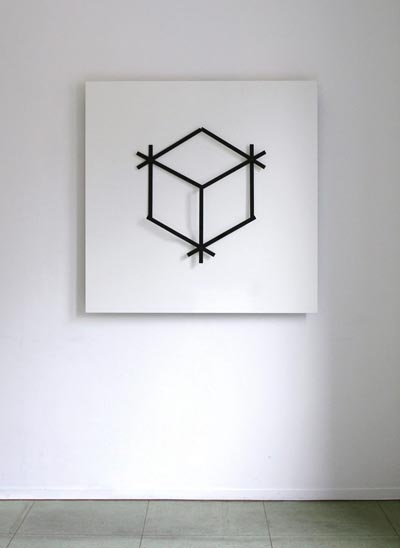One Perfect Cube
Three synchronized clocks, metal framing, master clock
120 x 120 x 20 cm
2010

[...], “One Perfect Cube” appears as a pure form at first glance, as an animated drawing undergoing a perpetual metamorphosis, whose creator is not quite sure about which shape it is finally going to take. Or, in fact, what it was once before. How is one to know? The image is structured by nine lines, conceived from the hands of three clocks, three lines of which move across the face at one time, tick-tock, according to the same congruent rhythm, as it were, seemingly culminating in clear, minimalist forms before they get condensed into compact bodies, tick-tock, only to disintegrate promptly into particles that are chaotic, or simply light as a feather and somewhat highly poetic. A new image with every second. With each one of these utterly abstract images doubling up as a kind of memento mori.
The very obvious movement of the hands, the never ending metamorphosis of the drawing leaves no doubt about that. Like wilted tulips or a broken glass in a Baroque painting. Only that in Jenett’s originally and formally strict drawing of a garden a new surprising, at times wondrous, flower appears every single moment, no matter how short it may be. Only to disappear again in a flash. Just once, every 12 hours in fact, resembling the precision of clockwork, the original image, the actual motif is depicted in the shape of a cube, a stable geometrical form that as such, one is tempted to say, successfully withstands the metamorphoses of time and also the world. And is, tick-tack, gone.
Admittedly, not 12 hours, not 24 or even 48 sufficed to capture the image as such in its perpetual action of finding and losing itself, of consolidation and dissolution, of growth and decay, which never stops time, but changes with every new moment. Fresh and rather beautiful to behold, something that is graphically inscribed in it, and just like the drawing as a pure form and a self-contained system continues on its daily rounds. And, in so doing, unhinges itself like linear time at the drop of a hat. [...]
Excerpt from the catalogue text "Tilt! or As time goes by" by Christoph Schütte. Full catalogue is available here.
The time lapse video below shows the work within a 24 hour time frame.